Classes
Mommy & Me - Ages 2-3
Our Mommy & Me program invites moms, dads, care-takers, guardians, or family members to join their little one for a morning of music and dance at John Hayes O’Neill Studio of Dance!
This is a perfect way to introduce your child to new environments, physical activity, being with their peers, and exploring their independence and self-expression, all while having the comfort of a loved one to help guide them through the class.
Our Mommy & Me program is also a wonderful bonding opportunity for you and your little one! Deepen your connection with your child by spending one-on-one time with them in our studio!
Pre-K Dance - Ages 4-5
Our Pre-K program promotes not only physical development but mental and emotional development, as well. Children learn to be with their peers and follow directions by building teamwork and communication skills. In a nurturing environment, through creative movement and dance, children gain self-confidence, independence and self-expression. While keeping your child engaged through fun and creative exercises, cognitive and motor skills are developed, as well as the introduction to basic ballet and tap terminology. This class serves as the precious beginnings to a love and future in dance at the John Hayes O’Neill Studio of Dance. Enrich your child’s life through the magic and power of music and dance!
Ballet
Ballet is the foundation of all styles of dance and the focal point of our studio. Dancers gain grace, poise, healthy body alignment and posture, self discipline and confidence, by practicing classical ballet technique and performance. Our Artistic and Associate directors have trained at some of the world’s most prestigious institutions for dance and offer our dancers a vast knowledge of all techniques of classical ballet. Class consists of barre, center, across the floor, choreography, and stretch. Technical fundamentals and ballet terminology are developed and enhanced through classical ballet training, which helps dancers in understanding and studying all forms of dance.
Pre-Pointe
Pointe work goes hand-in-hand with classical ballet training. Once a student is deemed technically fit by our Artistic and Associate directors, those eligible may add Pre-Pointe to their weekly dance curriculum.
During Pre-Pointe, dancers learn and practice the basics of pointe work. Pre-Pointe classes are conducted like classical ballet classes, but with special attention and focus on each dancer individually in order to ensure the proper safety, development, and alignment of their Pre-Pointe training.
Pointe
Dancers move onto Pointe once they have at least two years of Pre-Pointe training. Dancers take what they have learned in Pre-Pointe and expand on that training to be able to execute more difficult ballet vocabulary and movement on Pointe. Proper alignment and development are still at the top priority as dancers move up to Pointe from Pre-Pointe.
Variations
Dancers learn and master famous classical ballet variations from popular ballets such as Don Quixote, The Nutcracker, Swan Lake, Le Corsaire, Coppelia, and many, many more! This class is the perfect addition to any dancer wanting to deepen their ballet training, enhance their performance skills and enrich their classical ballet history knowledge.
Pas De Deux
“Pas De Deux,” is classical ballet terminology meaning “dance for two”. Pas De Deux classes focus on the technique, coordination, balance and support needed when dancing with a partner. Dancers will learn the basic physics on how to execute turns, jumps, lifts and much more with a partner. Pas De Deux class is essential for any dancer looking for a well-rounded classical ballet training and to better prepare them for when they may need to dance with a partner in one of our productions and beyond.
Modern
Modern is a dance form rooted in ballet technique that takes the classical lines from ballet and shapes them into unique phrases and movement. Modern also has an emphasis on emotional expression which helps dancers connect to the music they are dancing to and helps them better convey that message or story to an audience through their movement.
Jazz
Jazz is a high-energy style of dance with an emphasis on musicality, technical skills and theatrical execution. Jazz has many ranges of styles and techniques, including broadway jazz, street jazz, commercial jazz, and many, many more. Dancers will learn to execute these styles through stretching and conditioning, progressions across the floor, isolation and syncopation exercises at center and stylized choreographic combinations. Jazz builds performance quality skills that can be beneficial to all forms of dance.
Tap
Tap is a percussive form of dance that has a strong focus on understanding musicality and technical coordination. Tap incorporates rhythm, timing, and balance challenging the dancers not only physically but mentally, as well. Students develop a musical ear that is essential for all forms of dance helping them better understand and retain choreography, emotionally and rhythmically connect to music, and develop their creativity and improvisation skills.
Acro
Acro combines tumbling and gymnastic skills with flexibility and strength training. Dancers will learn to perfect and hone their skills and take on new and challenging acrobatic moves. With safety as our number one priority, dancers are under the supervision of the instructor and also given individual attention throughout the class to ensure that they are properly performing and practicing these acrobatic skills.
Body Conditioning
Body conditioning is a class designed to serve as a form of cross-training for our dancers. This class promotes injury prevention, development of flexibility, strength training, and athletic endurance. Dancers learn about body alignment and how to properly warm-up and use each muscle group to help them better execute the skills and techniques trained in their core dance curriculum. This class is beneficial to any dancer, no matter what level. Modifications can be made throughout the class in order to suit all abilities.












